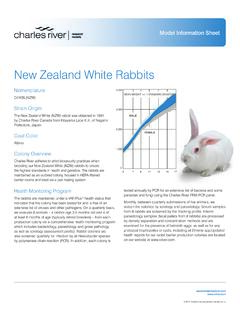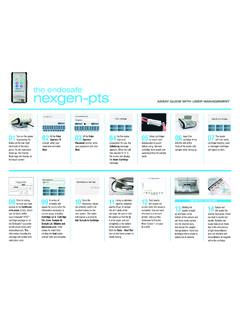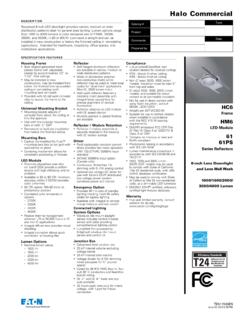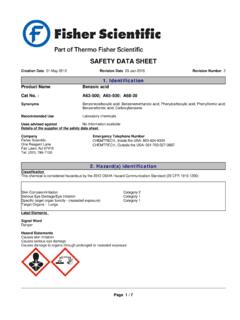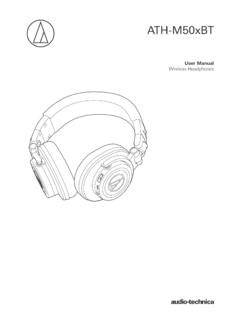Transcription of Trifluoroacetic Acid Material Safety Data Sheet (MSDS ...
1 Safety DATA SHEET1. IdentificationProduct NameTrifluoroacetic acidCat No. :A116-05 AMP; A116-1 AMP; A116-10X1 AMP; A116-2 AMP; A116-50 SynonymsTFA; Trifluoroethanoic acid; Perfluoroacetic acidRecommended UseLaboratory advised againstNo Information availableDetails of the supplier of the Safety data Sheet 2. Hazard(s) identificationClassification This chemical is considered hazardous by the 2012 OSHA Hazard Communication Standard (29 CFR )Label Elements Signal WordDangerHazard StatementsMay be corrosive to metalsHarmful if inhaledCauses severe skin burns and eye damageMay cause respiratory irritationMay cause drowsiness or dizzinessMay cause damage to organs through prolonged or repeated exposure_____Page 1 / 7 Revision Date 29-Oct-2014 Acute Inhalation Toxicity - VaporsCategory 4 Emergency Telephone NumberCHEMTREC , Inside the USA: 800-424-9300 CHEMTREC , Outside the USA.
2 001-703-527-3887 Skin Corrosion/irritationCategory 1 ARevision Number 1 Serious Eye Damage/Eye IrritationCategory 1 Creation Date 21-Sep-2009 Specific target organ toxicity (single exposure)Category 3 CompanyFisher ScientificOne Reagent LaneFair Lawn, NJ 07410 Tel: (201) 796-7100 Target Organs - Respiratory system, Central nervous system (CNS).Specific target organ toxicity - (repeated exposure)Category 2 Target Organs - Kidney, to metalsCategory 1_____Precautionary StatementsPreventionUse only outdoors or in a well-ventilated areaDo not breathe dust/fume/gas/mist/vapors/sprayWash face, hands and any exposed skin thoroughly after handlingWear protective gloves/protective clothing/eye protection/face protectionResponseImmediately call a POISON CENTER or doctor/physicianInhalationIF INHALED: Remove victim to fresh air and keep at rest in a position comfortable for breathingSkinIF ON SKIN (or hair): Take off immediately all contaminated clothing.
3 Rinse skin with water/showerWash contaminated clothing before reuseEyesIF IN EYES: Rinse cautiously with water for several minutes. Remove contact lenses, if present and easy to do. Continue rinsingIngestionIF SWALLOWED: Rinse mouth. DO NOT induce vomitingStorageStore locked upStore in a well-ventilated place. Keep container tightly closedDisposalDispose of contents/container to an approved waste disposal plantHazards not otherwise classified (HNOC) Harmful to aquatic life with long lasting effects3. Composition / information on ingredientsComponentCAS-NoWeight % Trifluoroacetic acid76-05-1>954. First-aid measuresEye ContactRinse immediately with plenty of water, also under the eyelids, for at least 15 medical attention is ContactWash off immediately with plenty of water for at least 15 minutes.
4 Immediate medicalattention is to fresh air. If breathing is difficult, give oxygen. Do not use mouth-to-mouthresuscitation if victim ingested or inhaled the substance; induce artificial respiration with arespiratory medical device. Immediate medical attention is not induce vomiting. Call a physician or Poison Control Center important symptoms/effectsCauses burns by all exposure routes. Product is a corrosive Material . Use of gastriclavage or emesis is contraindicated. Possible perforation of stomach or esophagus shouldbe investigated: Ingestion causes severe swelling, severe damage to the delicate tissueand danger of perforationNotes to PhysicianTreat symptomatically_____Page 2 / 7 Trifluoroacetic acidRevision Date 29-Oct-2014_____5.
5 Fire-fighting measuresSuitable Extinguishing MediaCO 2, dry chemical, dry sand, alcohol-resistant Extinguishing MediaNo information availableFlash PointNo information availableMethod -No information availableAutoignition TemperatureNo information availableExplosion LimitsUpperNo data availableLowerNo data availableSensitivity to Mechanical ImpactNo information availableSensitivity to Static DischargeNo information availableSpecific Hazards Arising from the ChemicalCorrosive Material . Causes severe burns by all exposure Combustion ProductsCarbon monoxide (CO) Carbon dioxide (CO2) Hydrogen fluorideProtective Equipment and Precautions for FirefightersAs in any fire, wear self-contained breathing apparatus pressure-demand, MSHA/NIOSH (approved or equivalent) and fullprotective gear.
6 Thermal decomposition can lead to release of irritating gases and 6. Accidental release measuresPersonal PrecautionsUse personal protective equipment. Ensure adequate ventilation. Evacuate personnel tosafe areas. Keep people away from and upwind of PrecautionsShould not be released into the environment. See Section 12 for additional for Containment and CleanUpSoak up with inert absorbent Material . Keep in suitable, closed containers for Handling and storageHandlingUse only under a chemical fume hood. Wear personal protective equipment. Do not get ineyes, on skin, or on clothing. Do not breathe vapors/dust. Do not containers tightly closed in a dry, cool and well-ventilated place. Corrosives Exposure controls / personal protectionExposure Guidelines This product does not contain any hazardous materials with occupational exposure limitsestablished by the region specific regulatory 3 / 7 Revision Date 29-Oct-2014 Personal Protective Equipment Instability0 Physical hazardsN/AEye/face ProtectionWear appropriate protective eyeglasses or chemical Safety goggles as described byOSHA's eye and face protection regulations in 29 CFR or European MeasuresUse only under a chemical fume hood.
7 Ensure that eyewash stations and Safety showersare close to the workstation acidFlammability0_____9. Physical and chemical propertiesPhysical StateLiquidAppearanceClear, ColorlessOdorpungentOdor ThresholdNo information availablepH 2 100 g/L Point/Range -15 C / 5 FBoiling Point/Range 72 C / F @ 760 mmHgFlash PointNo information availableEvaporation RateNo information availableFlammability (solid,gas)Not applicableFlammability or explosive limitsUpperNo data availableLowerNo data availableVapor Pressure107 mbar @ 25 CVapor with waterPartition coefficient; n-octanol/waterNo data availableAutoignition TemperatureNo information availableDecomposition TemperatureNo information cP at 25 CMolecular FormulaC2 H F3 O2 Molecular Stability and reactivityReactive HazardNone known, based on information to AvoidIncompatible products.
8 Exposure to moist air or water. Exposure to light. Excess MaterialsStrong oxidizing agents, Reducing agents, Acids, Strong bases, Metals, AminesHazardous Decomposition ProductsCarbon monoxide (CO), Carbon dioxide (CO2), Hydrogen fluorideHazardous PolymerizationHazardous polymerization does not ReactionsNone under normal Toxicological informationAcute Toxicity Product InformationComponent InformationComponentLD50 OralLD50 DermalLC50 InhalationTrifluoroacetic acid200-400 mg/kg (rat)Not listed10 mg/L/2h (rat)Toxicologically SynergisticProductsNo information availableDelayed and immediate effects as well as chronic effects from short and long-term exposure _____Page 4 / 7 Revision Date 29-Oct-2014 Trifluoroacetic acidRespiratory ProtectionFollow the OSHA respirator regulations found in 29 CFR or European StandardEN 149.
9 Use a NIOSH/MSHA or European Standard EN 149 approved respirator ifexposure limits are exceeded or if irritation or other symptoms are and body protectionWear appropriate protective gloves and clothing to prevent skin MeasuresHandle in accordance with good industrial hygiene and Safety severe burns by all exposure routesSensitizationNo information availableCarcinogenicityThe table below indicates whether each agency has listed any ingredient as a acid76-05-1 Not listedNot listedNot listedNot listedNot listedMutagenic EffectsNot mutagenic in AMES TestReproductive EffectsExperiments have shown reproductive toxicity effects on laboratory EffectsDevelopmental effects have occurred in experimental information - single exposureRespiratory system Central nervous system (CNS)STOT - repeated exposureKidney LiverAspiration hazardNo information availableSymptoms / effects,both acute anddelayedProduct is a corrosive Material .
10 Use of gastric lavage or emesis is perforation of stomach or esophagus should be investigated: Ingestion causessevere swelling, severe damage to the delicate tissue and danger of perforationEndocrine Disruptor InformationNo information availableOther Adverse EffectsThe toxicological properties have not been fully investigated. See actual entry in RTECS forcomplete Ecological informationEcotoxicity Harmful to aquatic organisms, may cause long-term adverse effects in the aquatic environment. Do not empty into drains. Theproduct contains following substances which are hazardous for the AlgaeFreshwater FishMicrotoxWater FleaTrifluoroacetic acidNot listedZebrafish: LC50: >1000mg/L/96hNot listeddaphnia: EC50: 55 mg/L/24hPersistence and DegradabilityPersistence is unlikely based on information AccumulationNo information likely be mobile in the environment due to its PowTrifluoroacetic Disposal considerationsWaste Disposal MethodsChemical waste generators must determine whether a discarded chemical is classified as ahazardous waste.







